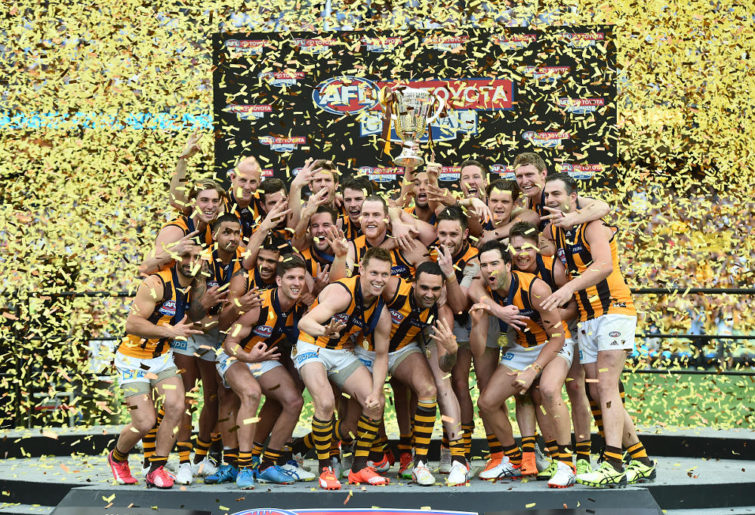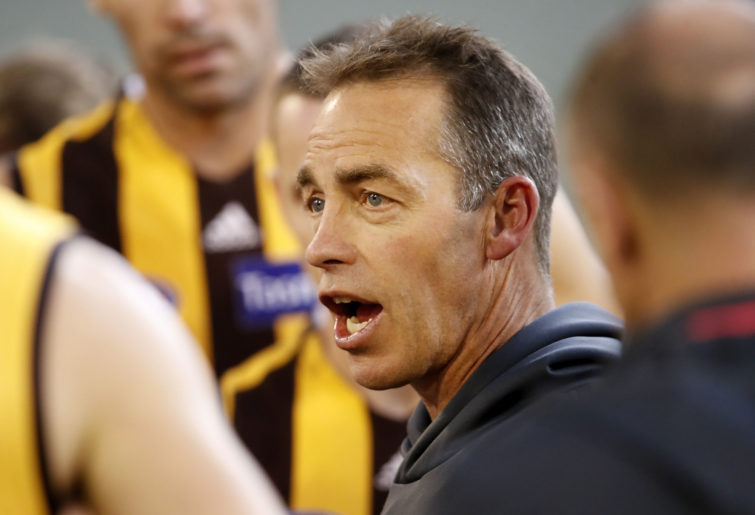With the 2019 season now officially over for the Hawks, all eyes will be on the list management decisions that are made by the football department in one of the more intriguing off-seasons the club has faced in some time.
From the outside looking in, the raw numbers make for some worrying reading for the Hawks.
At the start of 2019, the Hawks had the oldest list in the AFL with an average age of 24.9 years and the most experienced in terms of games played at 78.6 games per player. These are statistics that are not what you would expect from a team that has just finished the season in ninth place.
The narrative this season from most experts has been the Hawks’ ageing list, and in order to avoid an extended period either mid-table or worse, they must start looking to the draft to re-generate the list.
Or do they?
The Hawks have had two top 20 draft picks since 2009. Isaac Smith was selected with pick 18 in 2010 and Ryan Burton was taken with pick 19 in 2015. Burton was later traded to Port Adelaide 2018 with pick 15 for Chad Wingard.
During this period, the Hawks have only used their first round draft pick twice to enter the national draft.
When looking at the players that have been brought into the club during that time via trades and free agency, an interesting picture begins to emerge. Whilst there are some obvious misses, the list provides a who’s who of premiership players such as Josh Gibson, Shaun Burgoyne, David Hale, Jack Gunston, Brian Lake, Matt Spangher, Ben McEvoy and James Frawley.

(AAP Image/Julian Smith)
These players were all brought into the club between 2009 and 2015 – a period that saw the Hawks play in four grand finals, winning three. This clearly shows the Hawks list management strategy places more emphasis on bringing in mature-age players that meet a specific need rather than the draft.
The most obvious impact of this strategy is that it increases the overall average age of the list, which in most circles is seen as a negative. The Hawks are still selecting players in the draft, however they are generally second, third and fourth round selections, plus the rookie draft.
Whilst this can be considered a major risk, there are benefits to this strategy. Most players that nominate for the draft can play. It is accepted that some are considered more talented than others but all of these players have got to that level for a reason.
Conversely, not all first round draft selections go on to be premiership players. By carefully selecting players in the draft that have a specific skill set or quality, the Hawks are able to nurture these players at their VFL affiliate Box Hill to teach them their system and and iron out any deficiencies.
These young players are therefore not exposed to senior football until they are ready and generally there is no urgency to do so. In some cases, this is in their first season (such as James Worpel), however others take a bit longer (for example, Oliver Hanrahan).
Trading in mature-age players for the now allows the Hawks to operate in the lower end of the draft with some success. Consider the following names as an example of this strategy: Luke Bruest (2008 rookie draft selection 47), Paul Puopolo (2010 national draft selection 66), Liam Shiels (2008 national draft selection 34), Ben Stratton (2009 national draft selection 46), all men who played in premierships and all are 150-plus game players.
There are also examples in the current group such as James Sicily (2013 national draft selection 56), Blake Hardwick (2015 national draft selection 44), Daniel Howe (2014 national draft selection 31), Mitch Lewis (2016 national draft selection 76) and Tim O’Brien (2012 national draft selection 28).
All have played less than 100 games but are now becoming important pieces in the puzzle and will complement the next group of players that have arrived via trade since 2016: Tom Mitchell (26), Jaeger O’Meara (25), Ricky Henderson (30), Jarman Impey (24), Jack Scrimshaw (20), Tom Scully (28) and Chad Wingard (26). Will there be another vital cog added to the list this year?

(Photo by Dylan Burns/AFL Photos)
Over the years, there have been calls to lift the draft age to allow players to mature before being drafted, however the Hawks’ strategy in effect is doing this already.
The Hawks are currently holding nine players on their list that will be 30-plus at the commencement of next year. Other than Jarryd Roughead, who has retired, and potentially Tim Mohr, who suffered a season-ending injury early in the year, there may not be any further players moved on this season, which will come as a surprise to many on the outside.
Of the remaining seven players on this list, only Grant Birchall has played less than 18 games this season and two played all 22 games. These older players have been resilient and therefore the need to cull hard is not as critical as some may like to think.
They also provide much needed leadership to the younger players when they do experience senior football, and like Alastair Clarkson showed this year with Roughead, he is not afraid to drop the senior players to give the next generation an opportunity.
The Hawks now have their highest draft position for some time, with pick ten at present depending on whether any priority picks are handed out by the AFL. They are in the mix for Stephen Coniglio, who is a restricted free agent, however GWS may decide to force a trade by matching the offer, so the Hawks may once again need to use their first selection and possibly more to secure his services.
A choice between a ready-made gun in the prime of his career or selecting a couple of young top-end draftees where there are no guarantees. Given their track record during the Clarkson years, it’s hard to argue against this strategy. The Hawks have had two waves of premiership success in that time, and in the words of Clarkson, are building towards that third wave of silverware.
Whilst the Hawks missed the finals in 2019 finishing ninth, their overall record against the top eight teams was six wins and six losses, with their percentage seventh best in the league – and that’s playing four top eight teams twice. Wins against Geelong, Collingwood, GWS and West Coast in the second half of the season were also impressive.
Compare this with one of the form teams entering the finals – the Western Bulldogs – whose results against top eight opposition were four wins and five losses and they only played three top eight teams twice.
All this for Hawthorn was minus their 2018 best and fairest and Brownlow Medallist Tom Mitchell.
Despite what some people may think, there is blue sky ahead for these Hawks.
There are no guarantees in the AFL and we won’t know for sure whether this strategy is sustainable for some time. But with the best coach in the business at the helm, it would be a brave person to bet against it.
It looks like the Hawks are not only revolutionising the way the game is played on-field but also the way it is played off-field.































































































